Peter Watson willed land on the Gravelly Brook to his wife
Agnes (Philip's grandmother, his mother, and his daughter were all named Agnes) for life, and on her death to his
son David- Philip's uncle.
The text of the will includes "all the houses barns orcherds meadows both salt "and fresh with all the
appurtenances .... " indicating that the land was actively farmed from at least the 1720's
On this 100 hundred acre Watson plot (which would eventualy become the Magnolia Farm), Pierre
Fresneau, Phillip's father, who had married Agnes (the second) Watson (David's sister) two years before, built
the original house in 1752- the year Phillip was born.
The house became known as Mount Pleasant Hall and
was included in Historic Houses of New Jersey by W. Jay Mills, 1902
http://www.getnj.com/historichouses/freneaumountpleasanthall.shtml .
Ten years later in 1762 David Watson, out of love for his sister, deeded to
Phillip's father the hundred acre homestead along with nine other lots in Matawan, another 100 acres at Boles's
Mills, and a saw mill and thirty acres on the creek. (Poignantly, Philip himself would do the same exact thing 62 years later when, at the age of 72, he was
forced to move, and live out the rest of his life on a farm previously owned by HIS wife's brother-
Denise Forman.)
Phillip Freneau
Philip lived at Mount Pleasant Hall off and on during his many exploits in literature, at sea, and in
publishing. James Madison, Philip's good friend from Princeton would visit often and hit on Philip's sister Mary;
fortunately for Dolly (or James) he was not succesful.
As stated in the
History of the Democratic party from Wikipedia "The Democratic Party evolved from political factions that opposed Alexander
Hamilton's fiscal policies in the early 1790s; these factions are known variously as the Anti-Administration “Party”
and the Anti-Federalists. In the mid-1790s, Thomas Jefferson and James Madison organized these factions into the Democratic-Republican
Party."
http://en.wikipedia.org/wiki/History_of_the_United_States_Democratic_Party
On a fateful trip to New York in 1791
Thomas Jefferson and Madison prevailed upon Philip to edit and publish a paper, the National Gazett, in Philidelphia
to serve as a mouth piece for Jefferson's "Anti-Administration" views to counter Alexander Hamilton
and Wahington.
In 1793 after his most politically significant work in Philadelphia, he moved back to Matawan
and set up his own printshop on the grounds where he published a newspaper and collection of poems and other works.
| Page from Freneau's 1795 book |
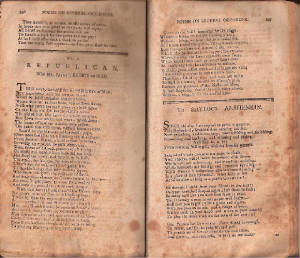
|
I was fortunate to obtain a copy of the collection
of poem's that Freneau printed at his home printshop (my kitchen if you believe Clarence Ware) in 1795.
This is a
page with a poem on Paine's Rights of Man.
The Fire (and birth of my house)
On October 18th, 1818 a fire
destoyed the original Mount Pleasant Hall.
Below is the entry Philip made himself about it in the family bible, where
he states:
"The old house at Mount Pleasnt accidentally took fire on Sunday afternoon
at 4 o'clock, October 18th - 1818 precisely one year after my mother's decease. It was consumed to the ground with
a large part of property therein. The following day we began to remove into the New House, which was partial finished. The
Old House was built in 1752 by my father - 42 feet in length and 24 in breadth."
Also, in a letter to Mathew Carey dated just a week later, Oct. 26, 1818,
Philip writes: "About a week ago I was burnt out and lost considerable of property, but fortunately no lives. I have
however a new house partialy finished, into which I have moved".
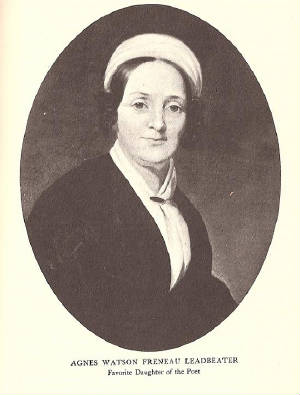
|
| Agnes Watson Freneau Leadbeater; from Mary Austin's book |
His daughter Agnes (the third), having just married Edward Leadbeater of
New York less than two years earlier, and Freneau (as usual) being rather poor at the time, this "new house"
(now mine and the subject of this web site) was not actualy his own, but was almost certainly a summer home being
built by his daughter.
Freneau lived in my house until 1824 when he moved to East Freehold,
where his wife had inherited part of her bother Denise Forman's farm. This is well documeted in "Freneau's
Last Home; Philip Marsh, and Milton Ellis, Houlton, and Maine; Proceedings New Jersey Historical Society; Vol. 57, No. 2;
April, 1939 (since the article was written during the Clarence Ware years, Marsh repeats the legend about the "print-shop").
"The Forman Geneology"; Miss Anne Spotswood Dandridge; 1903; states how Denise Forman and Philip Freneau
both fought at the battle of Germantown. It also states how Denise was a fellow prisoner with Freneau on the British prison
ship in New York harbour and that they were "perfect skeletons" when they were finally released.

To the right is the house
Freneau moved to in East Freehold in 1824 that was his brother-in-law Denise's. Freneau lived here until he died in 1832.
This is what became the "Poets's Corner" development on Kozloski road.
Freneau's movements
are also deduced by records from Freneau's eldest daughter, Helen who married John Hammel in 1816, and correlating
entries about Helen's children in the family bible (first pointed out by Leary):
- John Hamell's reciept book indicate
that they began renting a house in New York in 1819, just after the fire. So Helen and here husband may have lived with her
parents at the large Mount Pleasant Hall after they got married. But after the fire, when Philip had to move into the "New"
but smaller and partially finished house, Helen and her husband had to find their own loggings in New York.
- In 1822, however, the reciepts for the Hammel's
New York house stop, with Helen apparently moving back with her parents in my home. In the family bible we find Helen's
first daughter, Eleanor, being born at my home in 1823.
- After Philip moved to East Freehold in 1824 his daughter Agnes and her Husband finally
moved into the home they had built, my house.
- Helen apparently moved with her parents as the entry for her second daughter, Sarah, records
her as being born in 1826 at the "Freneau farm near Freehold".
- Again in the family bible we find that Helen's third daughter was born back at my
house in Mount Pleasant when Agnes was living here in 1830. Perhaps Agnes was better able to help Helen than her aged parents.
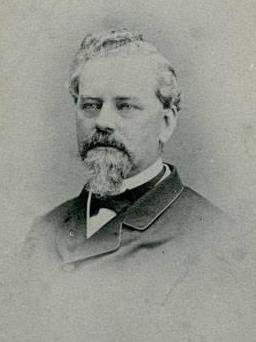 Agnes and her family lived in my house until
the death of her husband in 1832.
To the right is one of her children, Philip Freneau Leadbeater. Later in
life he changed his name to Philip Leadbeater Freneau. He was born in 1822.
He died in 1880 at his sister, Marianne Harris',
where his mother also lived her final years.
I have a copy of "Poulson's American Daily Advertiser"
from June 23rd, 1832 with what must be the last article on Freneau when he was alive that states that he would still (at 80) walk
the 10 miles from what is now Kozloski road back to Matawan to visit his grandchildren.
Edward Leadbeater
died on March 28th, 1832. Edward was buried on the Freneau family burial grounds "Locust Grove", where Philip's
Aunt Allaire was the first to be buried in 1789, and Philip's mother was buried in 1817.
In December of 1832
Philip Freneau himself died and was buried next to his mother in the Locust Grove. It is now a little cemetary
with a single monument to Philip and his mother, across the steet from my house maintained by the township.
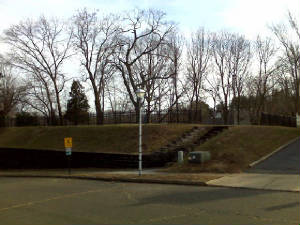
"Locust Grove" today. A little park across the street from my house
where Freneau, his mother and aunt, and son-in-law Edward Leadbeater, are buried, and his monument is maintained by the
township.
In 1840 an unpublished poem of Freneau's was found among the papers
of his daughter Helen, and describes his leaving my home in 1824 (when he would have been 72):
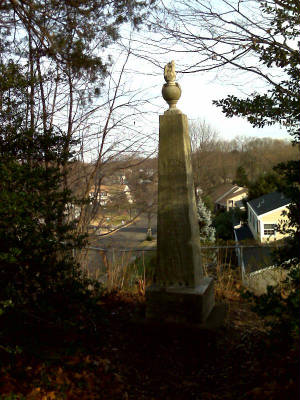
|
| Freneau's monument in the park |
I left the Mount, I left the shade
I left the neigboring mill
Where seventy years ago I played
With boys that called me "Phil"
I left the clear, the purling
stream-
The Gravelly Brook they call;
Where I once had full many a dream,
near locusts green and tall,
I left them all, for Monmouth's Plains,
Hard by the Southern Pines,
Where melancholy silence reigns,
And solitude combines
To bring to mind the seasons past,
And how much longer life may last.
The Magnolia Farrm
After the Leadbeater's the lot
came into the possession of Captain Garret Hiers, a sea captain in Middletown Point. In 1843 he sold the property, now called the
"Leadbeater lot or farm near Mount Pleasant" to Thomas Ryer and it began a long eventful tenure as the Magnolia
Farm.
The 1850 census for Middletown Point lists the Ryer Household as Thomas Ryer 41 and his wife Mary Ryer 38;
David G Ryer 15- who would later build Matawan's famous blue victorian on Main Street;
James B Ryer 9- who would
take over the farm;
Thomas C Ryer 7- who would fight in the civil war and die as a young man in 1870; Albert S.
Ryer 5, Robert Ryer 2, and John Stryker 24 a farm hand.
The 1860 census shows the addition of an Adeline
Ryer- wife of David who at 25 was still at home; and Denise and Catherine Sweeny as farm hand and servant. James B, who would
have been 19, is not listed at this time.
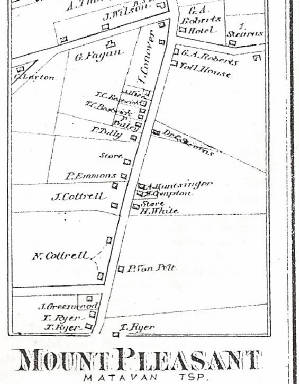
In 1870 the
household is down to Thomas senior and Mary, Thomas junior, Louisa- his wife, Nathaniel King- farm hand, Catherine Fritz-
domestic, and a Frank Trovey- listed as a Physician, perhaps a border.
To the left is a detail
from the famous 1873, Beers- Atlas of Monmouth County that showing Thomas Ryer as the owner.
To the right is a notice from
the Redbank Register of December 11th, 1895 that states that James B. Ryer was going to remodel the house for the new manager
of the farm, David Buck.
This timing would fit well for the addition of the Victorian porch, and remodeling of
the dormer servant quarters.
Following the Register notice is a short article from a year later talking
about the Buck's celebrating in their home. Apparently Buck taking the job coincided with his getting married.
Following that is aclassified from the Brooklyn Eagle of 1902 implying that David Buck is no longer there.
As lamented in this article from April of 1897, during the Ryer tenure
the connection with Freneau grew faint and his grave was neglected in the busy working Magnolia Farm.
Below from the Register of August 24th, 1898 is an article about James B. Ryer taking
first place at the Fifth Annual Horse Show of the Monmouth County Horse Show Association for "Addie W." one of the
Magnolia Farm's horses.

Below is the ancient Magnolia
tree in front of my house. It may be 150 years old and so definitely dates from the Ryer days. You can see some of the iron
bars and cabling that has been added over the years to preserve it.
It is still beautiful when it blooms.
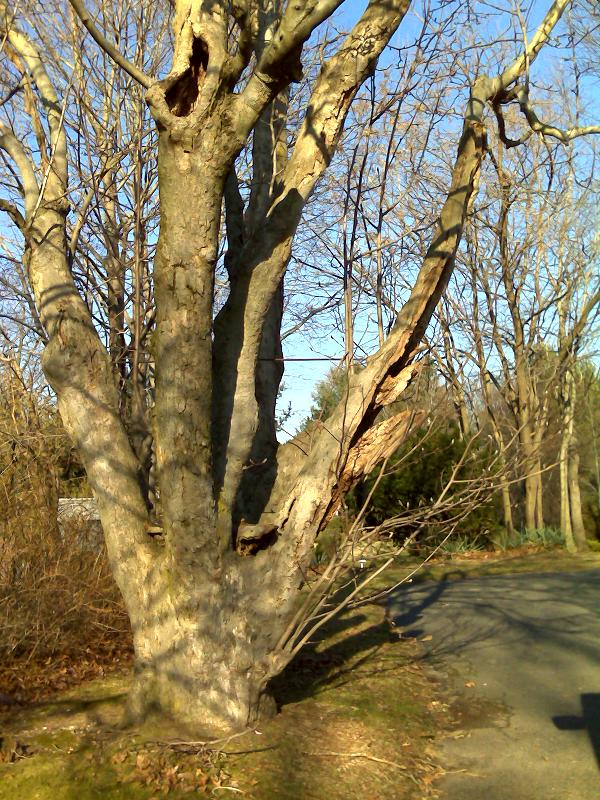
In 1910 the property changed hands and Howard Higgins (another gentleman farmer from New York) became
the next owner of the "Magnolia Farm".
Interest in Freneau, and the site, may have been increasing
as this large article from 1910 indicates.
Of my house, the article correctly states it was build by Freneau's
daughter and husband, the Leadbeater's.
The HIggins were horse people from New York (Mrs. Higgins was Mistress of a riding school
in the city). In this article from the Redbank Register 1914, they are looking for some tennent farmers to take care of the
place.
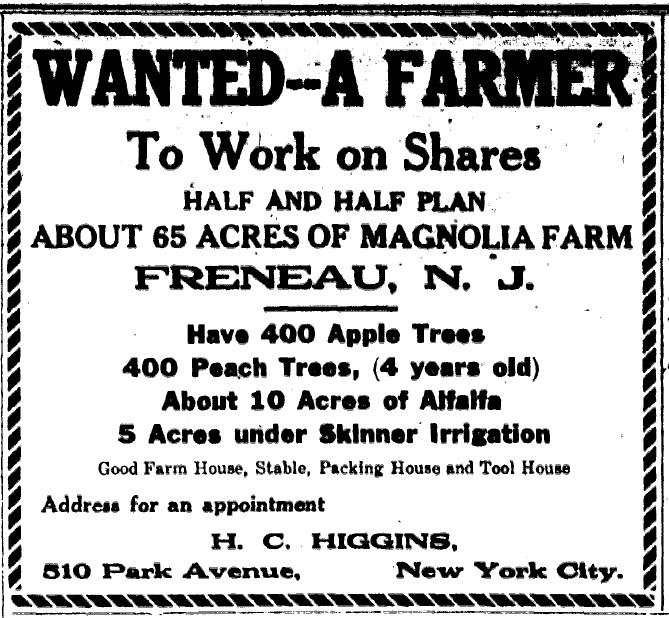
One notable improvement made
during the short Higgins tenure, as seen in this excerpt from a 1912 Redbank Register article, the house was wired for
electricity.
This actually helps date the finishing of the upstairs dormers.
Since the "tube and
post" fittings are visible in the attic, attached to the beams which finished the celing in the dormers, it indicate
that the dormers were finished before 1912, which would have been the 1895 re-model by James B. Ryer.
In 1918 the farm changed hands again.
From Higgin's time on, sale of the historic home made the news.
To the left is the notice of the "Former
Home of Philip Freneau" being exchanged farm to Fredrick Brown of New York for two appartment buildings in
the city.
Brown only held the property for a short time.
Below is an adverticement
for an auction held to clean out the place for the new residents.
Clarence Ware and the "Printshop"
Two weeks after the auction, we read in the July 31st Register and Matawan Journal
edition at the the time, that the Magnolia Farm was sold to the colorful Clarence Ware.
The property
is discribed as "consisting of 98 acres, large main house, about a dozen outbuildings, two other dwellings, stable,
etc, and was valued at $50,000".
On the map below I've outlined what I believe the lot looked like in
1918 based on a 1915 Matawan Township tax map, and a 1938 Marlboro tax map.
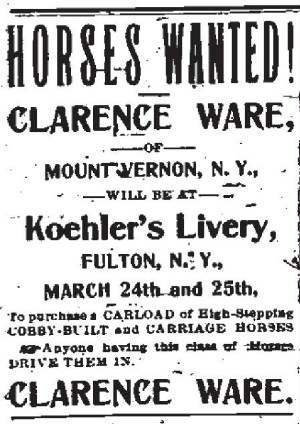 Clarence Ware was a well known horse dealer
from Mount Vernon New York, and so continued the Magnolia Farm's long tradition in horses.
As seen in
the add to the right, from an up-state newspaper, he would buy and sell horses by the car load.
He would also
speculate on trotters, often buying and selling the same day.
In his youth Clarence was a jockey, and not above, at least the appearance of shenanigans. In the article below from
1886, Clarence is accused of getting a new jockey drunk, and then selling his horse.
The charges were later dismissed.
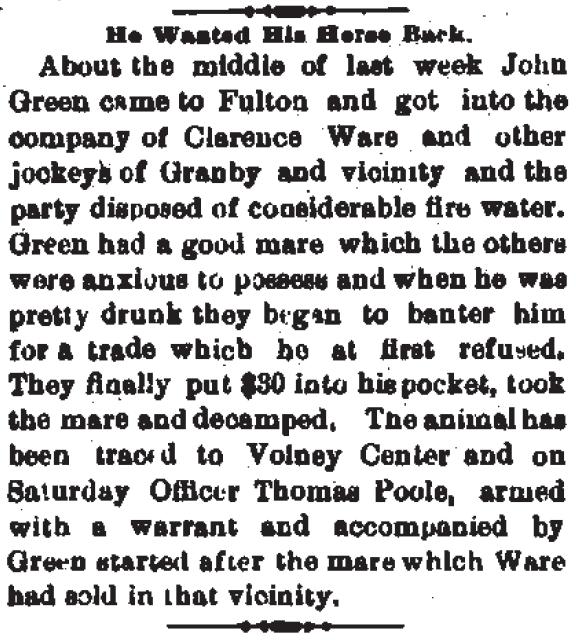
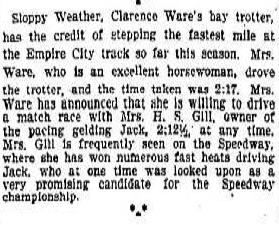
One of Clarence Ware's more successful
trades (at least from what we can glean a hundred years later) was the trotter "Sloppy Weather".
As seen
in the article to the right, like the Higgins before them, the Wares were both accomplished horse people, with Clarence's
wife Francis actually driving the horse to victory, and boldly challanging a comtemporary to a match race.
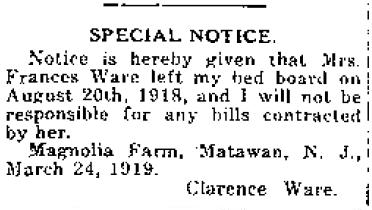
Sadly, however, the Wares did not share Magnolia Farm as Clarence's wife
never lived here.
We don't know whether moving to Jersey was the cause or affect of the seperation,
but though they would never divorce, Francis lived with her sister in New York until she died in 1941.
In the NY
Times article from 1927 below, just nine years after buying Magnolia Farm, Clarence was entertaining selling it
and began getting more interested in the Freneau connection as he engaged with the Monmouth Historical Society to try and
sell them Freneau's grave.
The Monmouth County Historical Society
couldn't afford his asking price, but fortunately he didn't sell at that time, so Freneau remained in Locust Grove.
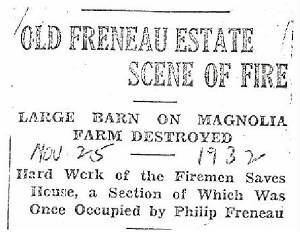
In 1932 there was a
major fire on the site when the large barn (125 ft) burnt down. The article at left says that a huge effort was required to
keep the house from burning down (again) also. It also says a large "garage" was saved. This may be the present
garage"as some estimates put it as old as the 20's.
Below is view of the house
from Freneau's monument across the street that shows the large detached garage. 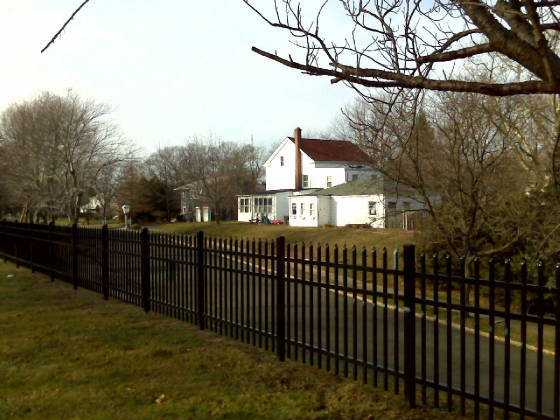
During the 30's he began advertising
the Freneau connection to his property. He would conduct tours of what he claimed was Freneau's original printshop (where
my present kitchen is). Below the WPA Writers Project "New Jersey- A Guide to its Present and Past" includes
the site on one of its tours.
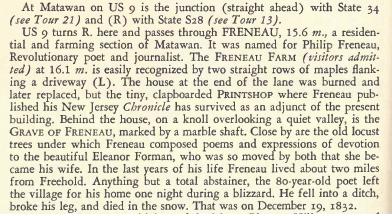
Also from the WPA in 1939 from their
"Matawan 1686 - 1936" we see below that the estate has taken on its shape of 15 acres and maple flanked driveway
that it would have until the subdivision in 1972.

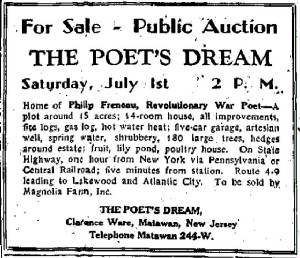 As seen in his add to the right
from 1939, Clarence Ware was prominantly featuring the Freneau connection when he tried to sell the property in
an auction.
The house was described as having 14 rooms; more than it has now, this would have included the
large addition to the right of the "printshop", removed in 1949 when the kitchen was built). It also highlights
the hot-water heat.
Since the notice says that it includes "fire logs" and "gas logs", this
may mean that the original fireplace (which was likely on the northside) was still used at that time.
The heating
system is one of my favorite features of the house. The system is industrial quality with enormous circulating pumps that
keep the house as warm as we want without the dryness of forced air.
As seen below, Clarence was still not successful
and he stopped the auction when the bid only reached $17, 000.
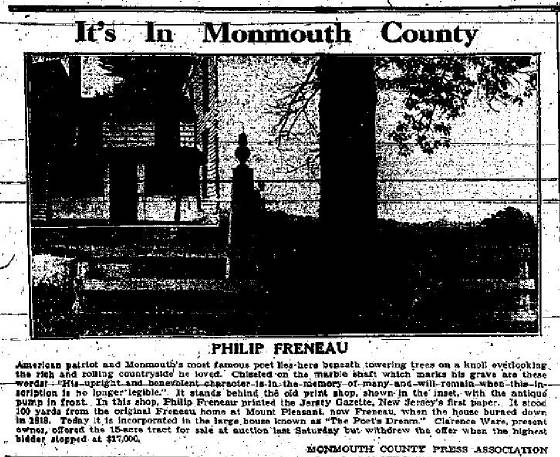
On November 5th, 1939
there was even a radio show broadcast from the site. Below is the cover and text of the listener's guide to the NBC
radio show "Ted Malone's Pilgrimage of Poetry" that was broadcast from my house.
It is well documented that Freneau
set up a printshop on the grounds, however its unclear if the building Ware showed was indeed Freneau's printshop as Clarence
admitted that he knew nothing of Freneau when he bought the property. There is one of the floorboards from the "printshop"
remaining in my basement that I may try and get some precise dating on.
Below is the accompanying picture
from radio show listeners guide of the "printshop" that Clarence Ware would give tours of. It is in the location
of where my kitchen (which was added in 1949) currently is. The building connected to the right is the main house, the building
to the left is gone.
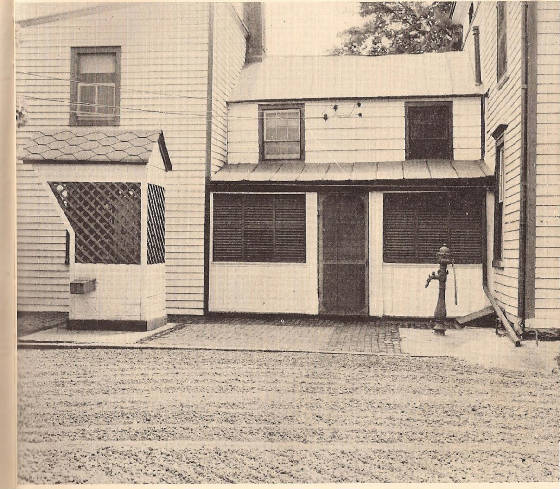
To the right is the same view today- my kitchen.
I found newspapers shoved in spaces, apparently for insulation
that dated from 1949, which leads me to believe that's when it was built. However the beams supporting it, visible in
the basement, are unusualy large timbers.
In 1948 Clarence Ware sold
the land (now 15 acres), my house, and other buildings to Rudolf Fritsch. During this time the major renovations were probably
done which included: - Adding a kitchen
and a room above it where the "printshop" stood in 1949 (which I deduced from the newspaper I pulled out of the
wall used for insulation);
- Adding two
additional rooms on the south side;
- Adding
steel "I" beam reinforcements in the great room; and
- Re-plastering over iron lath throughout the house.
Below is a 1963 picture from New Jersey Historical Society showing two rooms
on south side

In
1965 "Tours of Historic New Jersey" still listed the site as a place to see- "house private; path open
to poet's grave".
Fristch had a development
company, RAF, so it looks like he always intended to develop the property.
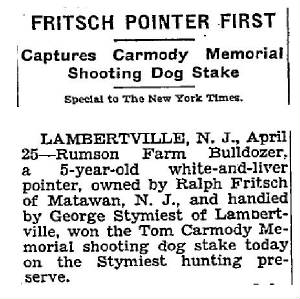
|
| Times article from 1954 |
He was also a
champion dog breeder, as you can see by this article from the TIMES in 1954.
The kennel was my existing garage. The concrete
footings for the outdoor dog runs are still on two sides of the garage.
Below is what the property looked like shortly before the final subvision into Poet's Drive.
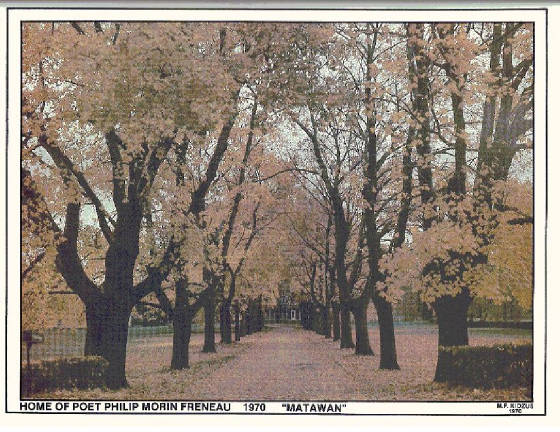
|
| 1970 picture of the driveway to my house from the Matawan Tricentennial booklet |
In 1972 Fritsch's
widow subdivided the land into its present form and the house was sold to Victor Armellino (the Mayor of Matawan at the
time) in 1973.
I bought the home in 2004 from the Armellino's and continue to discover many interesting things
about Freneau, the house itself, and its history, which I hope to publish here in detail.
Feel free to
contact me about the house at mikechartier@philipfreneau.com
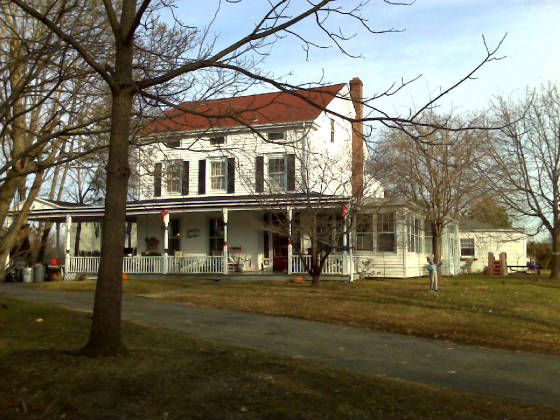
|
| The house today |
1 Secondary sources
are Philip M. Marsh who wrote multiple books and articles on Freneau including "Philip Freneau Poet and Journalist"
and a number of articles for the proceedings of the New Jersey Historical Society including "Freneau's Last Home"
in the April, 1939 volume; Lewis Leary who multiple books including"That Rascal freneau- A Study in Literary Failure",
and also contributed articles to the New Jersey Historical Society including Philip Freneau and Monmouth County for the July
1948 volume; Mary Austin's "Philip Freneau- The Poet of the Revolution"; the WPA writers "New Jersey- A
Guide to its Present and Past, 1939; New Aberdeen or the Scotch Settlment of Monmouth County New Jersey, James Steen 1899;
Matawan 1686 - 1936, Written and Illustrated by the Federal Writers Projects, 1939; Documents relating to the Colonial History
of the State of New Jersey, V 21; Evert A Duyckinck and others.
Primary sources include images of the Freneau family
bible, John Hammels notebook at the from the Monmouth County Historical Association Freneau Collection, deeds, newspapers
especially the Red Bank Register, Matawan Journal and New York Times, and other historical documents.
Also
special thanks to Stephen Gale, an Architectural Research Consultant, who shares a common interest in Freneau and his lands
and is helping me research.
|

